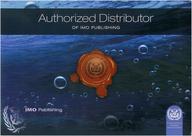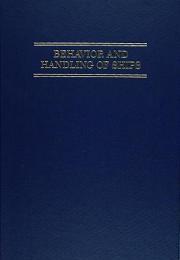Catálogo - LIBROS NÁUTICOS - Maniobra
Behavior and Handling of Ships
Autor: Henry H. Hooyer
Editorial: Cornell Maritime Press -Schiffer-
Año de edición: 1983
9780870333064
Encuadernación: cartoné
139 pág.
15,5 x 23,5 cm.
29,75€
Temporalmente sin existencias
Contenido:
Forces acting on the ship have an effective lever arm with respect to a hypothetical pivot point. The forces creating or affecting this pivot point include the ship’s motion, underwater resistance, and momentum. The book will be particularly helpful to pilots and ships’ officers, and those whose jobs require a thorough understanding of ship behavior.
Índice:
INTRODUCTION
Shiphandling opportunity
Considerations
Variables in shiphandling
Principles of shiphandling
Motion and resistance
Judging motion
Judgment and instruments
Approximations of magniude of forces
CHAPTER 1. THE PERIPATETIC PIVOT POINT
Posiion of pivot point
Longitudinal motion and pivot point
Wind effect and pivot point
Rudder effect and pivot point
Rotational inertia and pivot point
Rotational momentum and pivot point
Propeller effect and pivot point
Sternway and pivot point
CHAPTER 2. RUDDER AND PROPELLER
Rudder force, drift angle, and lateral resistance
Lateral momentum
Effect of longitudinal inertia on steering
Effect of trim on steering
Speed reduction of rudder and propeller
Turning circles
Rudder force and transverse thrust
Rudder angle
CHAPTER 3. WIND
Magnitude of wind-force
Head wind
Wind on the bow
Beam wind
Following wind
Wind and CBM
Beam wind on loaded VLCC
Wind and single buoy mooring
CHAPTER 4. BOW THRUSTER, TUGS
Effect of bow thruster
Comparing the effect of rudder and bow thruster
Effect of bow thruster during sternway
Rudder or bow thruster/tug
Comparing use of tug and bow thruster
Tug and pivot point
Tugs, wind and pivot point
Use of tugs
CHAPTER 5. CURRENT
Effect of wind and current
Effect of partial exposure to current
Fully exposed to current
Magnitude of current force on the beam
Wind and current in a CBM
Effect of swell
Current and momentum
Effect of momentum on entering a sheltered port
CHAPTER 6. THE ANCHOR
Dragging and dredging
Conventional buoy mooring
Making the approach to the CBM
Anchor and swing
Anchor and position fo pivot point
Leaving the CBM
Stern anchor
Emergency
CHAPTER 7. NARROW CHANNELS
Bank effect
Stern suction and pivot point
Bow cushion and pivot point
Breaking a sheer
Using bank effect to advantage
Suction on entering port
Meeting and passing
Overtaking
CHAPTER 8. PRACTICAL APPLICATIONS
Case 1. Undocking a 25,000-dwt tanker
Case2. Docking a 36,000-dwt tanker
Case 3. Docking a 50,000-dwt tanker
Case 4. Undocking a 70,000-dwt tanker
Case 5. Undocking a 100,000-dwt tanker
Case 6. Docking a 140,000-dwt tanker
Case 7. Docking a 190,000-dwt tanker
Case 8. Undocking a 250,000-dwt tanker
Doppler readings
Shiphandling theory
Handling big ships
Angle of approach
APPENDIX A. LATERAL MOTION
1. Lateral resistance
2. Effect of longitudinal motion
3. Long levers
4. Long levers under. Longitudinal motion
5. Short levers
6. Short levers under. Longitudinal motion
7. Effect of tugs under headway
8. Effect of tugs under sternway
APPENDIX B. ROTATIONAL MOTION
1. Lateral resistance
2. Steering lever and lateral resistance lever
3. Turning circle
4. Turning in own length
5. Turning with transverse force on the bow
6. Turning with bow thruster
7. Turning on the anchor (loaded ship)
8. Turning on the anchor (light ship)
APPENDIX C. COMPARISON TABLE
Dimensions, diameter turning circles, stoppong distance
REFERENCES
INDEX
ABOUT THE AUTHOR
Precio: 29,75 €, I.V.A. incluido (4%)
[ Volver ]


